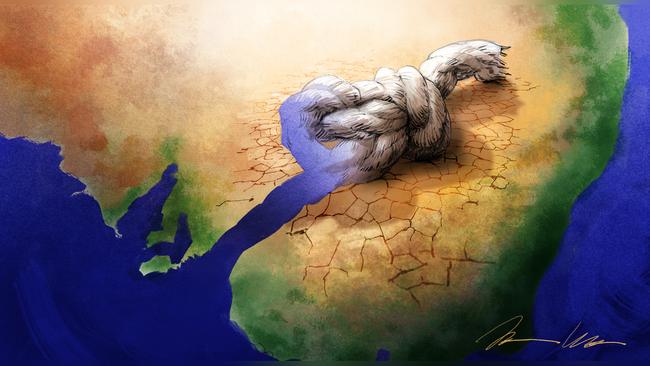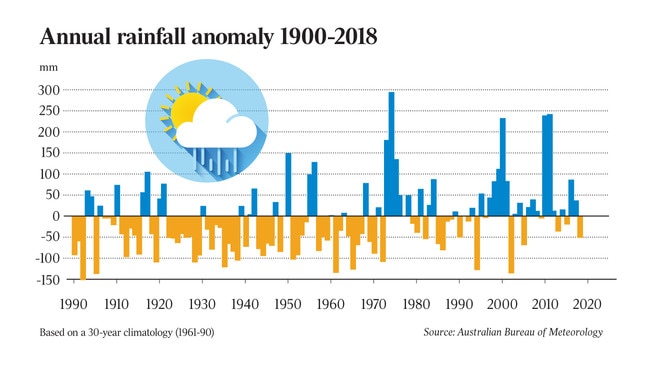Governments created this Murray-Darling crisis

Drought Minister David Littleproud is to meet farming representatives on Tuesday to discuss a fivefold increase in prices of Murray-Darling water. The minister attributes this to speculator hoarding together with another villain, climate change, which he says “is leading to hotter days, meaning droughts”.
Neither of these factors are the cause of the farmers’ discontent.
Although the Murray-Darling, like much of Australia, is in serious drought, this is not unusual. Other areas are seeing record rainfall; for Australia as a whole, rainfall has increased during the past century.
As for the minister’s attack on speculators, he targets an ever-convenient and populist scapegoat.
Independent ownership of water was facilitated when the rivers’ water was formally made tradeable in 2014 (before which trades were informal and ostensibly water could be owned only by the landowner).
Unless they are monopolists — and the sheer number of water owners makes this impossible — speculators simply respond to market opportunities. In this way, speculators perform a useful function in ironing out supply and demand imbalances and selling scarce supplies to those whose willingness to pay shows they need them most.
The real reasons behind the distress of irrigated agriculture are government policies that have reduced water availability.

Across the course of the 20th century, irrigation had transformed the Murray-Darling Basin from an arid region to one that produced more than 40 per cent of the nation’s agricultural output. The basin’s irrigators have long seen rival claims to the water from those at the Murray mouth, where allocated flows have created artificial permanent freshwater lakes.
But alternative uses were claimed in the 1990s by activists, calling themselves the Wentworth Group, whose members included Tim Flannery, David Karoly and Mike Young, the author of a column last week in this newspaper (“Drought of good ideas has drained water policy”). In addition to claims that irrigation was depriving natural vegetation of water, the Wentworth Group sought to wind back irrigation use on the basis of salinity with bloodcurdling claims such as “Salt destroying our rivers and land like a cancer”.
The fact is the Murray-Darling has become a working river. It experiences highly irregular annual flows of between 7000 and 118,000 gigalitres within an average 34,000GL. By 1997, dams along the system had allowed about 12,000GL a year to be granted to irrigators under levels of accessibility that vary with each year’s water availability. This not only brought the region’s agricultural bounty but converted a highly irregular river into placid waterway for tourists.
Wentworth Group activists recruited the ABC and other media as supporters in its agenda to reallocate the water flows from agriculture. In response, the Howard government bought up water from farmers for environmental purposes and, in doing so, set in place bureaucratic machinery that could readily expand the reallocation. This was tailor-made for the election of the Rudd government when climate change psychosis became the catalyst for further reducing irrigation water.
The 2008 Garnaut report, which was written by Steven Kennedy, who recently was appointed Treasury secretary, claimed that climate change meant the Murray-Darling area would be faced with permanent drought.
The report argued that we should start now to reduce water use generally in preparation for the period under which no irrigation would be possible.
Under Rudd’s radical environmentalist water minister, Tony Burke, the stakes were raised and 2750GL were to be bought from irrigators or created (by water-saving expenditures). At a cost of $13bn, this meant taking 20 per cent of a vital input into farming.
Inevitably, reduced output as well as higher prices have been caused by this government-induced scarcity. Ironically, the reduction in farmers’ water availability took place when the government was proclaiming a new dawn in demand for farm produce from the burgeoning Asian economies.
While making minor revisions, today’s federal government has accepted the thrust of the policy set up by its predecessor.
Blaming twin bogeymen of speculators and climate change is no solution to the problems governments have created. The Murray-Darling water policy has been a disaster for the region and the nation.
The solution is to accept the reality that the river system, before recent years’ reallocation of irrigation water, was in good condition. The more regular flows that the dams have allowed contributed to this as well as creating a thriving agricultural province. The only way of repairing the damage must start with the government selling back to irrigators the stocks of water that it now owns.
Regulation Economics’ Alan Moran is a director of the Australian Environment Foundation.



The Murray-Darling is the only major region where irrigation plays a prominent role. Water availability there has the urgent attention of politicians because locals, unhappy at measures that have deprived farmers of water, have helped displace Nationals representatives in favour of those from the Shooters, Fishers and Farmers Party.